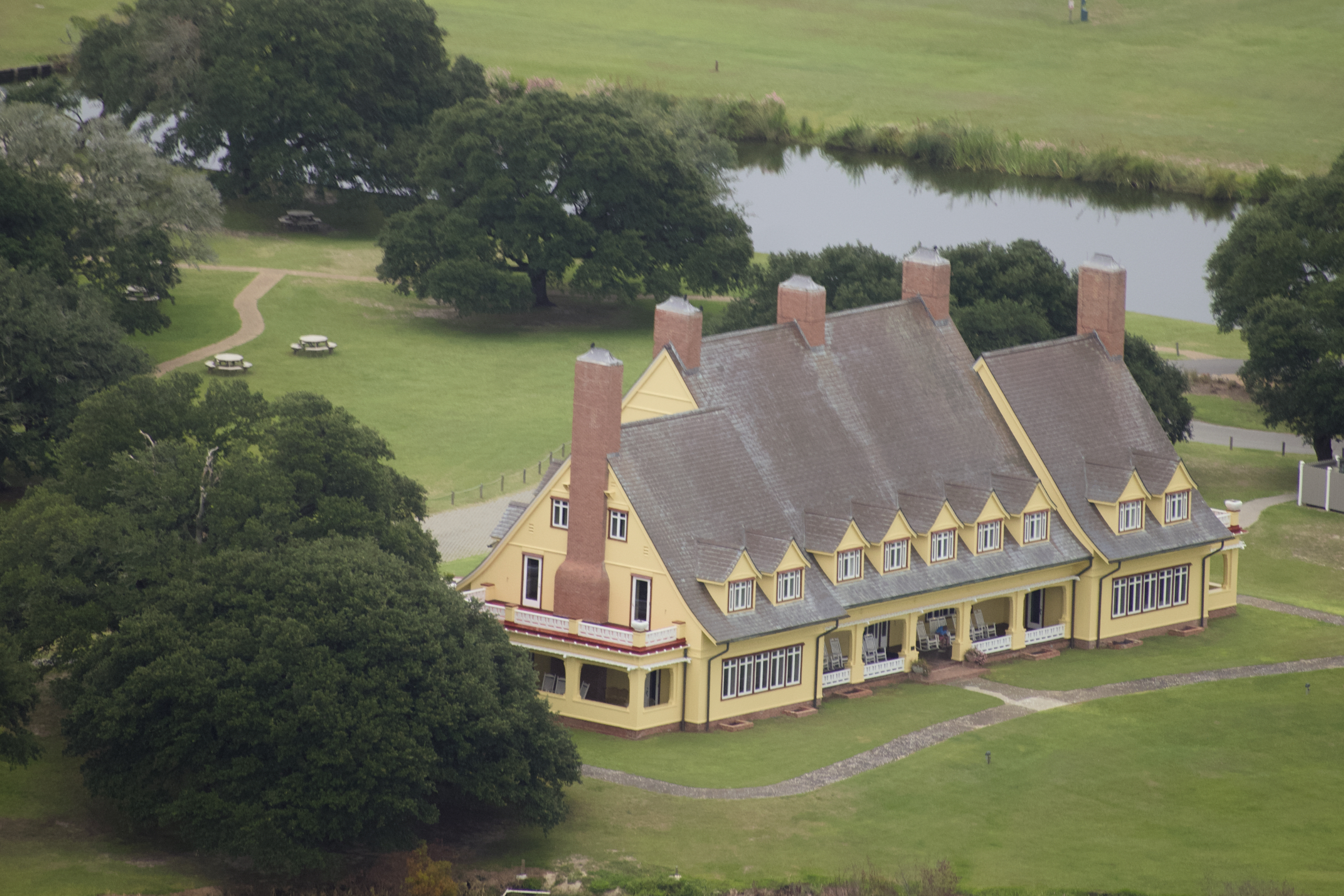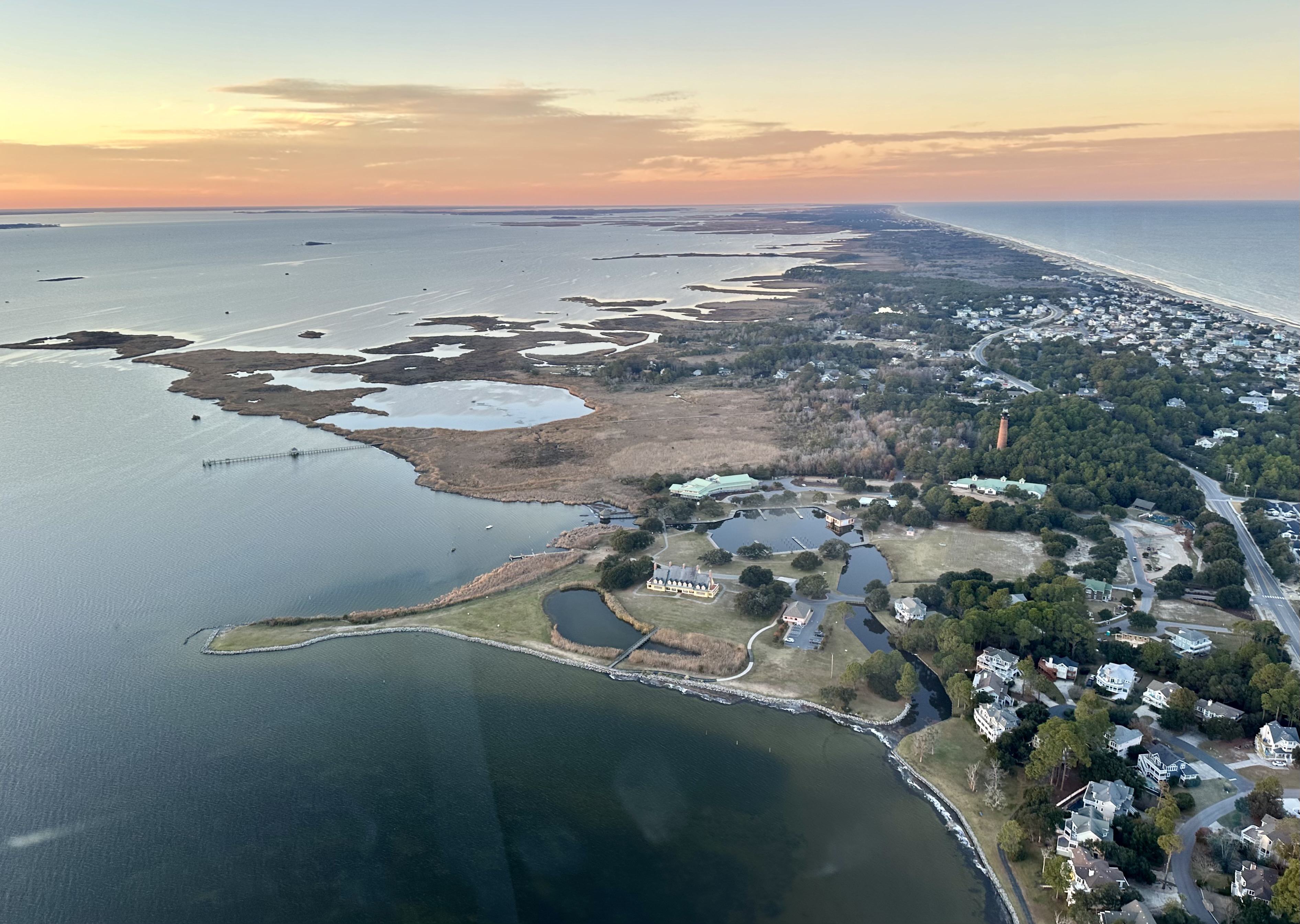Whalehead Club Celebrates 100 Years
The Whalehead Club, the iconic 21,000 square foot art nouveau mansion that is the centerpiece of Currituck County’s Historic Corolla Park is getting ready to celebrate its centennial birthday. That will be happening in October this year.
And there is a lot of history to celebrate.
Back in November of 1992, when Currituck County bought the building and 28.5 acres of land, it was a decrepit shell of its former self. The windows were broken and the interior had been exposed to the elements for years. There was six feet of water in the basement. It had become an illicit party house and fires had been lit in its many rooms.

Nonetheless, the county paid $2.8 million for the building and grounds, a move so unpopular with the county voters that every commissioner on the board at the time of the purchase was voted out of office.
The commissioners, though, had done their homework. What they knew was what the National Register of Historic Places had noted in 1978.

“Successfully constructed to withstand the most severe coastal storms, Whalehead Club remains a local landmark and a startling surprise to newcomers unprepared for the presence of such a grand and exotic structure,” the report noted.
It took ten years and more than $1 million to finish the renovation, but the Whalehead Club of today has been restored to its original glory.
Early History
Construction began in 1922 on what would become the Whalehead Club, and when completed three years later, Edward C. Knight and his wife Marie-Louise LeBel had spent $383,000 (approximately $7.1 million in 2025) on their vacation getaway cottage and hunting lodge.
The house was built on an artificial island created by dredging and raising the ground level enough to support the massive building. Its first name, Corolla Island, paid tribute to the moat and hill on which it stood.
For the next nine years, the Knights and their guests were regular visitors to Corolla. Edward Knight, who kept meticulous notes on visitors and daily events, made his last entry on November 24, 1934. At that time his health was failing and on July 23, 1936 he passed away. Marie Louise died three months later.
In the 1930s, the nation was mired in the Great Depression, and Knights’ heirs had no interest in maintaining Corolla Island and went looking for a buyer for the house and the 2000 acres of marsh and sound.
U.S. Representative Lindsey Warren, representing northeastern North Carolina, informed his colleagues about Corolla Island, and New York Congressman Sirovich agreed to purchase it for $175,000. The closing date was to be December 17, 1939 — the same day Congressman Sirovich suddenly died.
Ray Adams and the Whalehead Club
Ray Adams, a Washington, DC meat packer who seemed to know everyone in the capital was the next bidder and was able to buy the property for $25,000 in early 1940.
Adams gave the property its name.
“According to tradition, in the process of clearing land for the air strip that would facilitate transportation of guests, a whale bone was found, which prompted Adams to rename his estate Whalehead Club,” the National Register of Historic Places notes in their documentation.
Although interested in hunting, Adams had other plans for his purchase, planning on using the 2000-acre estate to woo “government officials who controlled the contracts that provided the bulk of his business.”
Adams saw the Whalehead Club as a business opportunity and, to that end, formed the Whalehead Club, Incorporated and issued 10 shares, eight of them going to himself and his wife.
And then the United States entered WWII. The Coast Guard needed a training and patrol site and business development plans were put on hold. In 1942, Knight agreed to rent the Whalehead Club to the Coast Guard. Barracks were built on the ground—they no longer exist—and at one time up to 300 Coast Guardsmen were on site.
The Coast Guard patrolled the Currituck Beach on horseback. Although it cannot be confirmed, there are persistent rumors the Spanish Mustangs of the Corolla Wild Horse herd were used.
After the war, Adams came up with a new plan for a resort community on the Currituck Banks.
What followed is something that has not been reported on as much as some of the other tidbits of history of the Whalehead Club. Adams was deep into planning an expansive beachside resort…something along the lines of a Myrtle Beach.
At the time, there were no paved roads north of Kitty Hawk, and to make his concept feasible, Adams began using his government contacts to lobby for a beach toll road from Duck to Virginia Beach.
The plans are on file with the Olmsted Archives, Frederick Law Olmsted National Historic Site. Listed as Job#10031, Whalehead, the plans for Adams by Olmstead Brothers Landscape Architects show a toll road with a 100-foot right of way, a yacht basin, a shopping center, and a fishing pier.
The toll road, though, was a problem. A Carolina Virginia Turnpike Authority was created as a private company. North Carolina passed legislation that would have allowed the CVTA to condemn property under the authority of eminent domain law. The North Carolina Supreme Court shot that down, ruling that a private company could not be legislatively given the powers of a municipal government.
The CVTA also found there was no appetite for bonds to finance a toll road that would involve two states and two jurisdictions, and by 1956, it was clear the project was not moving forward.
A Boys’ School and the Space Race
Adams died on New Year’s Eve, 1957, and again the property went onto the auction block, selling to Virginia Beach contractors for $375,000. The building and immediate grounds were subsequently leased to the Corolla Academy a”comprehensive summer school for boys…” according to the school’s brochure.
It is unclear why the school failed—it may have been the remote location. Perhaps parents did not see the need for a comprehensive summer school for boys, but after three years, it closed its doors.
What followed was an intriguing footnote to the space race.
As the United States and the USSR were locked in an arms race, Atlantic Research Corporation (ARC) was in the thick of it, working to develop rocket engines for weapons and space exploration.
A powerful fuel was needed and ARC was experimenting with beryllium. As a fuel, beryllium has some real advantages; it’s very powerful and it’s relatively stable. It is, however, extremely toxic.
Isolated from large population centers, the Whalehead Club checked all the boxes for security, preventing prying eyes and the toxic fuel from contaminating critical infrastructure.
ARC signed a lease/purchase agreement in 1961 and exercised its purchase agreement for $1.25 million in 1964.
Beryllium, though, was not going to be a practical fuel and in 1972, ARC sold the property to Norfolk real estate developers Kabler & Riggs for more than $3 million. The developers subdivided the property but left the 35 acres around the Whalehead Club building intact.
The building sat vacant for 20 years, but as the Historic Places noted in its 1978 report, the building, with its I-Beam construction and 18-inch thick walls, had been “successfully constructed to withstand the most severe coastal storms…”
Obligated to pay off the loan for the 1992 purchase of the property, Currituck County was not able to begin a full restoration of the building until 1999, when 25% of occupancy tax collections could be used.
In 2002, ten years after the property had been purchased, the Whalehead Club opened to the public.
Inside was the original custom made Steinway piano. Some of the original Tiffany sconces were still intact, and at other places, exact replicas had been created. Careful research of auction records had enabled the team working on restoration to track down a surprising number of original furniture pieces. By the time it opened to the public, the county had spent over $1 million in restoring the building.
The Whalehead Club is available for tours. Reservations are recommended.
